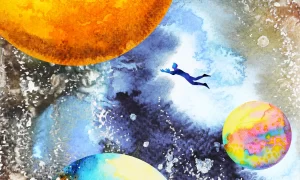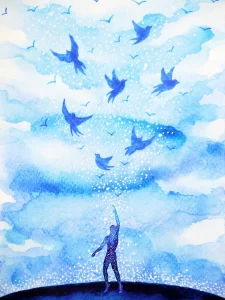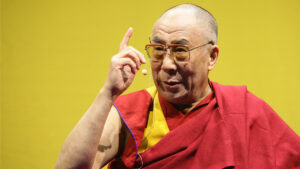Buddhism
Radical Transformation
January 15, 2022“Being fully present to what is happening in the world is a radical act that can transform grief into action.”
YES! Magazine
By Dahr Jamail
In this excerpt from the new anthology “A Wild Love for the World: Joanna Macy and the Work of Our Times,” journalist Dahr Jamail describes how Macy and her work helped him survive profound war trauma and climate grief.
Macy, a scholar and teacher of Buddhism, systems thinking, and deep ecology, is the author of 13 books and a respected voice in movements for peace, justice, and ecology. She originated The Work That Reconnects, a framework and methodology for personal and social change. It is influential work that, in the face of overwhelming social and ecological crises, helps people transform despair and apathy into constructive, collaborative action.
[…]
During one of Joanna’s discussions, she said, “The most radical thing any of us can do at this time is to be fully present to what is happening in the world.” For me, the price of admission into that present was allowing my heart to break. But then I saw how, in the face of overwhelming social and ecological crises, despair transforms into clarity of vision, then into constructive, collaborative action. “It brings a new way of seeing the world, freeing us from the assumptions and attitudes that now threaten the continuity of life on earth,” Joanna said.
[…]
There is more and more social hysteria, greatly aided by the corporate media and its finger-pointing and scapegoating. On one hand, you have the mass shootings, and on the other, a deathlike closing down under the pressures of the moment when you need to just get food on the table.”
Illustration by Benjavisa Ruangvaree.
I felt like little more than a typist for Gaia as the feelings and words flowed out of me, as I bowed to and held in reverence our magnificent planet. With each passing day, it became clearer to me that my work was truly in service to the planet, each chapter an homage to her. And along the way, she brought in Native American elders, which literally changed the ending of the book I had prepared. It was due to my training with Joanna that I knew what was happening and allowed myself to be Gaia’s instrument.
No matter how difficult life on Earth becomes, we will only be able to withstand these times by sharing ourselves with one another. If nothing else, we can bear witness together and not suffer in isolation as the dominant culture prefers. In being a “we,” humans can live as the deeply interconnected consciousness of Earth that we already are, just as Joanna has taught all of her life.
Yes. But what is the ‘we’ now? We are no longer deeply connected, only ideology connected and fractions are deep within each. Jesus spoke of ‘thou’, you, but contemporaneously it is only ‘me’ and perspectivism. ‘We’ know what needs to be done, but can ‘we’, will ‘we’? Hope is nothing more than a gamble, and we have no more chips.
R A D I C A L T R A N S F O R M A T I O N
…desperately needed, as ‘we’ exist in a state of radical uncertainty.
Mindful, Selfless, and Compassionate
June 5, 2021Harvard Business Review
Andreas Rentz/Getty Images
Summary.
The Dalai Lama shares his observations on leadership and describes how our “strong focus on material development and accumulating wealth has led us to neglect our basic human need for kindness and care.” He offers leaders three recommendations. First, to be mindful: “When we’re under the sway of anger or attachment, we’re limited in our ability to take a full and realistic view of the situation.” Also, to be selfless: “Once you have a genuine sense of concern for others, there’s no room for cheating, bullying, or exploitation; instead you can be honest, truthful, and transparent in your conduct.” And finally, to be compassionate: “When the mind is compassionate, it is calm and we’re able to use our sense of reason practically, realistically, and with determination.”
by the Dalai Lama with Rasmus Hougaard
What can leaders do?
Be mindful
Cultivate peace of mind. As human beings, we have a remarkable intelligence that allows us to analyze and plan for the future. We have language that enables us to communicate what we have understood to others. Since destructive emotions like anger and attachment cloud our ability to use our intelligence clearly, we need to tackle them.
Fear and anxiety easily give way to anger and violence. The opposite of fear is trust, which, related to warmheartedness, boosts our self-confidence. Compassion also reduces fear, reflecting as it does a concern for others’ well-being. This, not money and power, is what really attracts friends. When we’re under the sway of anger or attachment, we’re limited in our ability to take a full and realistic view of the situation. When the mind is compassionate, it is calm and we’re able to use our sense of reason practically, realistically, and with determination.
Be selfless
We are naturally driven by self-interest; it’s necessary to survive. But we need wise self-interest that is generous and cooperative, taking others’ interests into account. Cooperation comes from friendship, friendship comes from trust, and trust comes from kindheartedness. Once you have a genuine sense of concern for others, there’s no room for cheating, bullying, or exploitation; instead, you can be honest, truthful, and transparent in your conduct.
Be compassionate
The ultimate source of a happy life is warmheartedness. Even animals display some sense of compassion. When it comes to human beings, compassion can be combined with intelligence. Through the application of reason, compassion can be extended to all 7 billion human beings. Destructive emotions are related to ignorance, while compassion is a constructive emotion related to intelligence. Consequently, it can be taught and learned.
Buddhist tradition describes three styles of compassionate leadership: the trailblazer, who leads from the front, takes risks, and sets an example; the ferryman, who accompanies those in his care and shapes the ups and downs of the crossing; and the shepherd, who sees every one of his flock into safety before himself. Three styles, three approaches, but what they have in common is an all-encompassing concern for the welfare of those they lead.”
Full piece:
Cultivating community.
July 25, 2017“I commit to cultivating community by finding kindred spirits along the path, soul friends with whom I can share my deepest longings, and mentors who can offer guidance and wisdom for the journey.”
#3/The Monk Manifesto
︶⁀°• •° ⁀︶
“It is for [us] to understand that nothing happens as a punishment but rather as a lesson. It is our birthright that we should learn and grow from life. It doesn’t matter what the circumstance; look for the spiritual truth. Look for the light behind every bit of darkness. We are here to learn and grow and become. There are no accidents. When we realize that everything is happening for our spiritual growth, we can ask, ‘What am I to learn from this?’ ‘What possible good is in this situation?'”
-Science of Mind
︶⁀°• •° ⁀︶
“So much of the time we think our good is somewhere down the line, that we will be ‘king our purpose’ at some time in the future. Well, surprise. You are living your purpose right now – each word out of your mouth, each action you take.”
-Rev. Karen S. Wylie
︶⁀°• •° ⁀︶
Alfonso Montuori, California Institute of Integral Studies:
“According to neuroscientist Anil Seth, we’re all hallucinating all the time; when we agree about our hallucinations, we call it “reality.”
Neuroscientist explains how your brain hallucinates your conscious reality:



